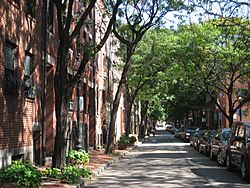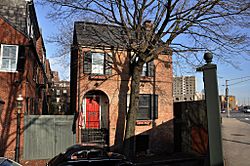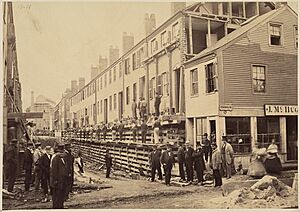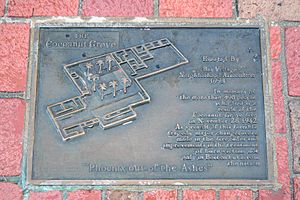Bay Village, Boston facts for kids
Quick facts for kids
Bay Village
|
|
|---|---|

Bay Village, Boston
|
|
| Country | United States |
| State | Massachusetts |
| County | Suffolk |
| Neighborhood of | Boston |
| Population
(2010)
|
1,312 |
| Time zone | UTC-5 (Eastern) |
| Zip Code |
02116
|
| Area code(s) | 617 / 857 |
| Website | www.bayvillage.net |
Bay Village is the smallest official neighborhood in Boston, Massachusetts. As of 2010[update], about 1,312 people lived here. Most homes are small brick rowhouses, which are houses built in a row and sharing side walls.
Contents
Discover Bay Village
Bay Village is a quiet and friendly place for walking. Its streets are narrow and mostly one-way. This means there isn't much car traffic. Many sidewalks are made of brick. At night, old-fashioned gas streetlamps light the way. One small street even has its original cobblestones!
Where is Bay Village?
The neighborhood has clear borders. The Massachusetts Turnpike is its southern edge. This big road follows an old railroad path from the 1830s. To the southwest, you'll find the South End. To the southeast is Chinatown. The Back Bay neighborhood is to the west. To the north is Park Square. The Washington Street Theatre District is to the east.
Historic Charm
In 1983, a special area of Bay Village became the "Bay Village Historic District." This means that the outside look of buildings is protected. It helps keep the neighborhood's historic feel.
Parks and Green Spaces
Even though Bay Village is small, it has some nice parks nearby. Eliot Norton Park is just across Charles Street. The famous Boston Public Garden and Boston Common are also very close. They are only two blocks from the northern edge of Bay Village.
Community Life
Bay Village used to be a middle-class neighborhood. But since the 1990s, it has become more expensive. The Bay Village Neighborhood Association (BVNA) is a very active group. They work to keep the area clean and peaceful. They help with things like traffic, litter, and pet waste. The BVNA also organizes fun events. These include Spring and Fall Cleanup days. They also have a book club. A popular event is the Annual Neighborhood Block Party. At this party, restaurants set up tables right in the middle of the narrow streets!
A Look Back: Bay Village History

The western part of Bay Village was once part of the Back Bay. This was a body of water. In the 1820s, a developer named Ephraim Marsh filled in this area with land. This happened before the larger landfills in the Back Bay and South End. Over time, Bay Village has been called different names. These include the Church Street District, South Cove, and Kerry Village.
Unique Architecture
Many homes in Bay Village look like smaller versions of the grand Beacon Hill townhouses. This is because the skilled workers who built homes in Beacon Hill lived here. They built their own homes in Bay Village. Fayette Street has many houses from the Federal Period (late 1700s, early 1800s). Larger, five-story homes in the Greek Revival style can be found on Melrose Street. Later, luxury "residential hotels" in the Victorian style were built on Cortes and Isabella Streets.
Raising the Village
In 1868, most of Bay Village was physically lifted up. This was done to fix sewage problems. These problems happened because nearby areas like the South End and Back Bay had been filled in. About 457 houses and 24 other buildings were raised by 12 feet (3.7 meters). This was a huge engineering project! It cost a lot of money, but it was important for public health. The work took about two years to finish. After the buildings and streets were raised, and new sewers were working, the properties were given back to their owners.
You can still see signs of this today. Look at the basement windows in some buildings on Fayette Street. They might seem unusually low. Also, some private gardens were never raised. They remain at their original, lower levels.
Edgar Allan Poe's Connection
The famous American writer Edgar Allan Poe was born near Bay Village. His parents were actors in the nearby Theatre District. A special plaque on Boylston Street remembers his birth. The house where he was born no longer exists. In 2009, the intersection of Charles and Boylston Streets was named "Edgar Allan Poe Square" in his honor.
In 2014, a bronze sculpture called Poe Returning to Boston was placed in Edgar Allan Poe Square. It shows a life-sized Poe walking against the wind. A raven flies beside him. His suitcase has opened, leaving a trail of his literary works on the sidewalk.
The Cocoanut Grove Fire
Bay Village was the location of a very sad event in November 1942. A fire broke out at the Cocoanut Grove nightclub. Many people died in this terrible fire. Because of this tragedy, strict fire codes were created across the United States. These new rules helped prevent similar disasters in the future. They also led to better ways to treat burn victims.
To remember the event, the Bay Village Neighborhood Association placed a memorial plaque. It is in the sidewalk near where the club used to be. The plaque says:
The Cocoanut Grove. Erected by the Bay Village Neighborhood Association, 1993. In memory of the more than 490 people who died in the Cocoanut Grove fire on November 28, 1942. As a result of that terrible tragedy, major changes were made in the fire codes, and improvements in the treatment of burn victims, not only in Boston but across the nation. "Phoenix out of the Ashes"
A smaller message on the plaque notes that it was made by Anthony P. Marra. He was the youngest survivor of the fire.
In 2013, a short street running through the old club site was renamed "Cocoanut Grove Lane." This renaming ceremony was attended by fire survivors and many guests.
Getting Around Bay Village
Bay Village is a great place to walk! As of 2016[update], it was rated as the fourth most walkable neighborhood in Boston. Boston itself is one of the most walkable cities in the US. Bay Village also has excellent public transportation.
Public Transport
Several MBTA train stations are just outside Bay Village. Many local bus routes also serve the area. Long-distance trains stop at Back Bay Station and South Station. Both are within walking distance. Inter-city buses leave from the South Station Bus Terminal.
Nearby train stations include:
- Arlington (Green Line)
- Back Bay (Orange Line)
- Boylston station (Green Line)
- Tufts Medical Center (Orange Line)
Driving and Parking
Finding on-street parking in Bay Village is very hard. Most spots are for residents with special permits. However, there are many commercial parking garages nearby. The neighborhood is also very close to major highways. These include the Massachusetts Turnpike (I-90) and the Central Artery (I-93).
Nearby Areas
Bay Village is surrounded by other interesting Boston neighborhoods and districts:
- Back Bay
- Chinatown
- Park Square
- South End
- Washington Street Theatre District
Images for kids






